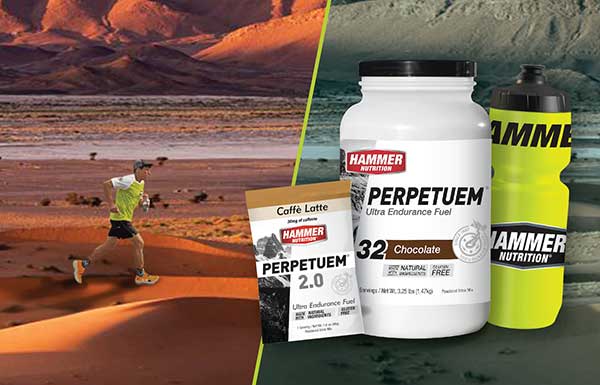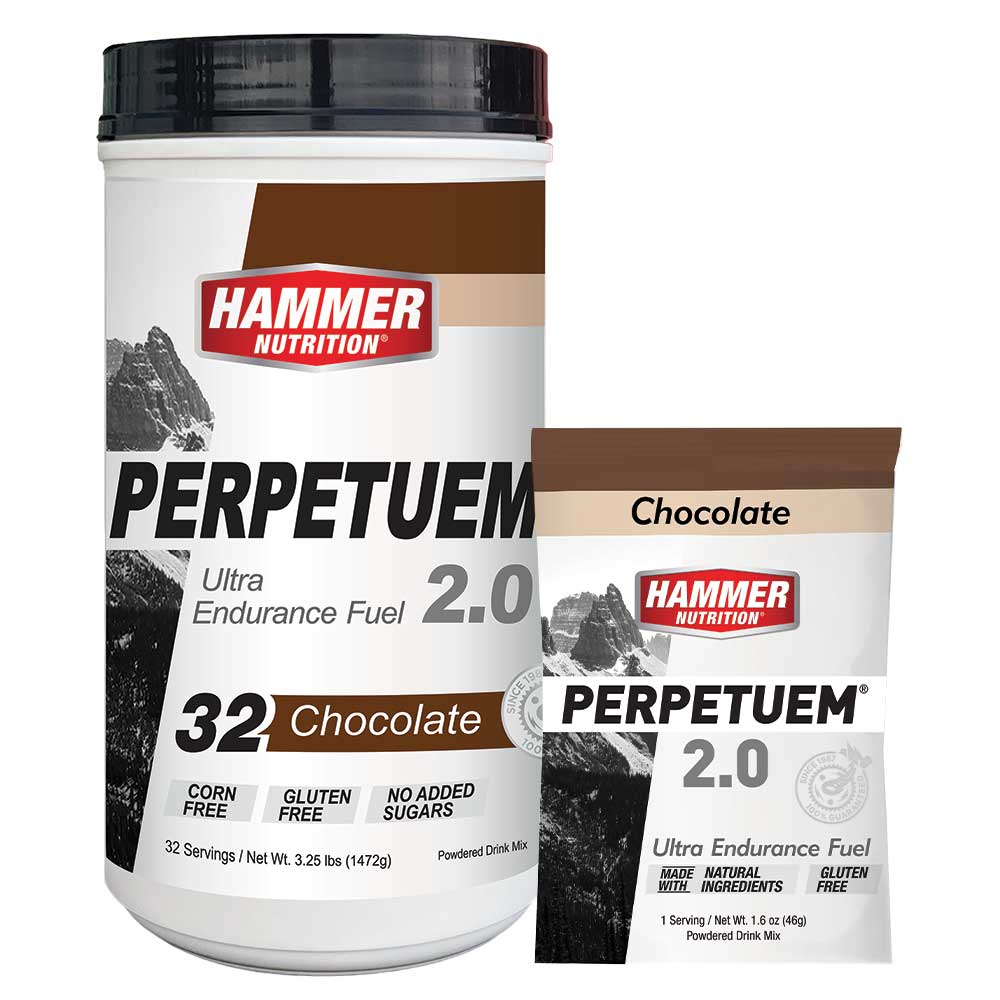
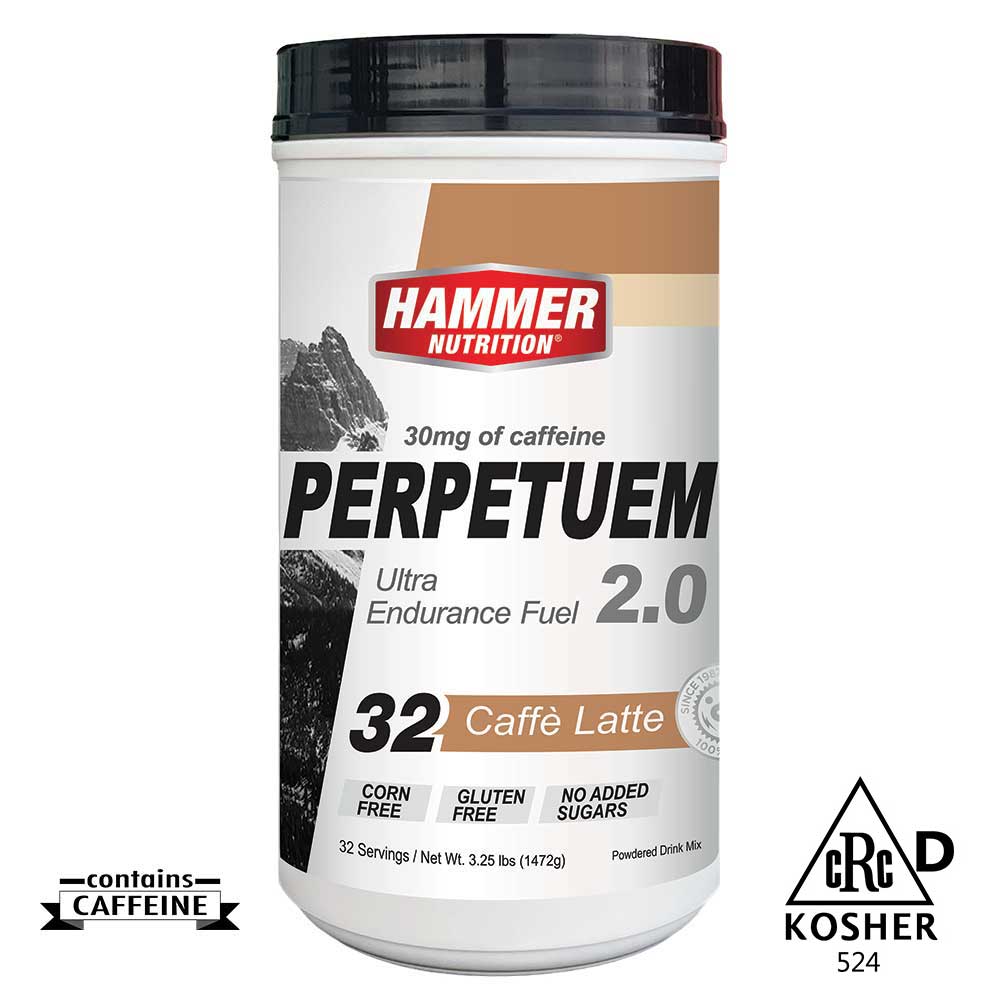
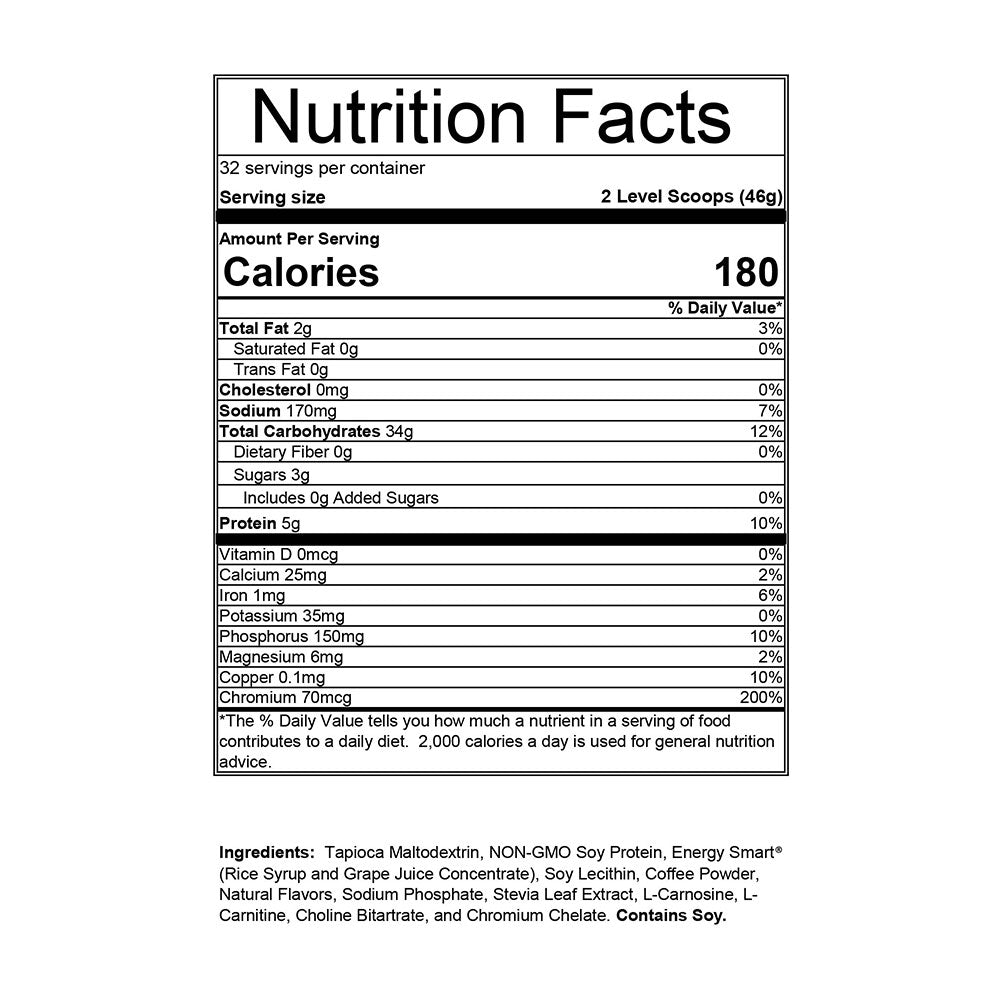
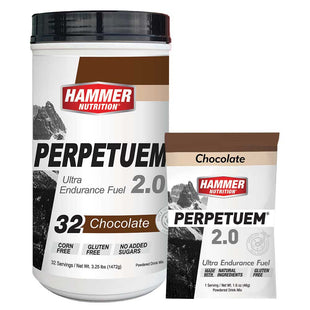
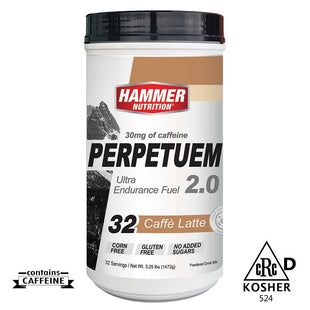
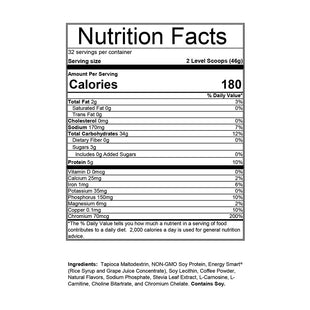



Perpetuem®
- New tapioca formula
- Steady energy, hour after hour
- Spares muscle, burns fat
- Caffé Latte flavor contains 30 mg of caffeine per serving
2.0 = Tapioca, Classic = Corn
Quantity:






Perpetuem satisfies your body’s energy requirements when exercise extends beyond three hours. Its unique blend and precise ratios of complex carbohydrates, protein, healthy fat, and key support nutrients allow you to stay strong and steady from start to finish.
Thoroughly tested and proven in the world’s toughest events since 2002, Perpetuem has been massively improved by replacing the corn maltodextrin with tapioca maltodextrin. The names may be similar, but these two carbohydrates are worlds apart! With far less processing, no GMO content, lower amounts of sodium and higher amounts of naturally occurring potassium, a more-alkaline pH, and lower mono and disaccharide content/much higher percentage of polysaccharide content (courtesy of its lower Dextrose Equivalent), tapioca is the sugar and corn alternative we’ve been wanting to bring to you for years is finally here!
Whether you’ve been using Perpetuem for 20 years or are thinking of trying it for the first time, you are going to be impressed with this 2.0 version, guaranteed!
Caffé Latte flavor contains 30 mg of caffeine per serving.
Classic Perpetuem - The original fan favorite, corn based formula introduced in 2002.
2.0 Perpetuem - Updated with tapioca maltodextrin derived from cassava, a far superior energy source and it’s Paleo friendly.
Read all about it here: Six Reasons why Tapioca is TOPS!
- Why did you switch to a tapioca-derived maltodextrin for Perpetuem 2.0?
- Should I use Perpetuem or Sustained Energy?
- What is the benefit of making a multi-hour bottle of Perpetuem, and how do I make it?
- When would I use HEED or Perpetuem?
- Why did the price of Perpetuem decrease?
- Why did the serving size change?
- How soon after mixing Perpetuem and Sustained Energy do they need to be consumed?
- How Should I Mix Perpetuem Or Sustained Energy For A Hot-Weather Event?
- Is It Okay To Mix Perpetuem Or Sustained Energy And Keep It Refrigerated?
- How do I determine the equivalent of one scoop of Perpetuem?
- What is the difference between Perpetuem and Perpetuem Solids?
- Can Perpetuem and HEED be used in a hydration pack's bladder?
- What is the “best used” time frame once opened?
- Does Perpetuem contain caffeine?
- Can my teenagers use Perpeteum?
- Can I use Recoverite or Vegan Recoverite during a long workout or event?
- Why do you use maltodextrin instead of sugar in your fuels?
- Is Sodium Phosphate, found in Race Day Boost and Perpetuem, safe to Consume?
- Which version of HEED, Perpetuem, and Recoverite are Kosher certified?
- Is the soy protein in Perpetuem non-GMO?
- What is the source for iron in Perpetuem?
- Is there a recipe for a soy-free Perpetuem?
- How can I prevent any clumping from happening when mixing my fuel bottles?
Why did you switch to a tapioca-derived maltodextrin for Perpetuem 2.0?
Our carbohydrate-containing fuels used a corn-derived maltodextrin (complex carbohydrate), which was actually a very good maltodextrin. However, we found that tapioca (cassava root)-derived maltodextrin offers the following advantages over corn-derived maltodextrin, which is why we made the switch:
- Tapioca requires far less processing than corn.
- Unlike corn, there is no GMO content in tapioca to begin with, so even though all the corn-derived maltodextrin we used in our products tested at 0ppb for GMOs, going with tapioca just saves us that hassle.
- Tapioca maltodextrin has naturally lower amounts of sodium and higher amounts of naturally occurring potassium. Given that most everyone consumes far too much sodium as it is, having more potassium and less sodium is a definite plus.
- Tapioca maltodextrin has a more-alkaline pH than corn-derived maltodextrin. Considering that we athletes are “acid-producing machines” during exercise, a more-alkaline pH is a highly desirable during-exercise feature/benefit.
- Tapioca maltodextrin has a lower Dextrose Equivalent (DE), which means lower mono and disaccharide (short-chain sugar) content, and a much higher percentage of polysaccharide (complex carb) content--in essence, a more “complex” complex carbohydrate--for even longer-lasting energy and endurance.
- Tapioca maltodextrin has same Glycemic Index (GI) as other forms of maltodextrin, so you get the fast-acting energy that you’re looking for.
SHOULD I USE PERPETUEM OR SUSTAINED ENERGY?
Hammer Nutrition offers two superb long-distance fuels in powder form – Sustained Energy 2.0 and Perpetuem 2.0. Sustained Energy 2.0 (“SE” as it’s commonly referred to) was introduced in 1992; Perpetuem first became available in early 2003. The newer 2.0 versions of both fuels were introduced in 2022. Perpetuem 2.0 and Sustained Energy 2.0 are intended to be used as your primary or sole fuel when exercise goes beyond two hours.
Deciding whether to use Sustained Energy 2.0 or Perpetuem 2.0 (or both) will undoubtedly be influenced by personal preference; however, there are a few differences between these two time-proven fuels that can assist you in the selection process.
CALORIES: Every 2-scoop serving of Perpetuem 2.0 contains 180 calories. Sustained Energy 2.0 contains 200 calories per 2-scoop serving.
PRIMARY INGREDIENTS: Sustained Energy 2.0 contains a 7:1 ratio of complex carbohydrates to soy protein and is fat free. Perpetuem 2.0’s carbohydrate-to-protein ratio is approximately 8:1, with 2.0 gramsof healthy fat (soy lecithin, sunflower oil) added to every 2-scoop of the formula.
Three reasons for the inclusion of this specific fat in Perpetuem 2.0 are:
- To act as a natural preservative, increasing the “shelf life” of the carbohydrate and protein components
- To assist the body in more liberally releasing its fatty acids stores, which account for up to two–thirds of one's energy requirements in long bouts of exercise
- To slightly slow the rate of digestion and thus decrease hunger pangs
AUXILIARY NUTRITIENTS: Perpetuem 2.0 contains Sodium Phosphate (aka Sodium Tribasic Phosphate). This nutrient was not added to the Sustained Energy 2.0 formula. Primary among its benefits, Sodium Phosphate is a powerful acid-buffering nutrient, reducing the burning sensation effects of lactic acid buildup. Both fuels contain l-carnosine, which is also an effective acid-buffering/pH-neutralizing compound.
FLAVORS: Sustained Energy 2.0 has always come in a neutral (“plain”) flavor. Perpetuem 2.0 comes in four flavor options—orange, strawberry, chocolate, and caffe latte (includes 15 mg of caffeine per scoop).
OTHER FACTORS TO CONSIDER
We have noted that Sustained Energy 2.0 may be the ideal fuel choice when endurance exercise intensity is at a higher level (approximately 70–85% MHR), whereas Perpetuem 2.0 may be a more attractive choice the longer the athlete goes and when exercise intensity is at a more aerobic pace (under 70% MHR). Additionally, over the course of many years we have noted that Sustained Energy 2.0 may be the best option for very lean athletes (the “high metabolizer/hyper–metabolic” types), while Perpetuem 2.0—with its added healthy fat component—may be more appropriate for athletes with a naturally higher body fat percentage. The rationale for this suggestion is that athletes with a higher body fat percentage have a greater volume of calories available from body fat stores, which the healthy fat in Perpetuem 2.0 may effectively assist in accessing for use as energy.
Bottom line: With Perpetuem 2.0 and Sustained Energy 2.0 you have two great long distance fuel choices. When exercise goes beyond about two hours, you can use either product as your sole fuel, in tandem with each other, or as your primary fuel along with any of the other Hammer Nutrition fuels. Taking into account the earlier-listed differences between the products, as well as testing each product under a variety of conditions in your long–duration workouts, will allow you to determine which fuel works best for you.
What is the benefit of making a multi-hour bottle of Perpetuem, and how do I make it?
While athletes love how Perpetuem works, many do not like to drink large volumes of flavored liquid hour after hour. Making Perpetuem in a bit more-concentrated, multi-hour bottle will resolve that, with most athletes making a bottle that contains 4 hours’ worth of Perpetuem. Here’s how to do it:
Each scoop of Perpetuem 2.0 contains 90 calories. Athletes weighing ~200 pounds, may use up to 2.25 scoops an hour, which supplies 202.5 calories. For light-weight athletes, 1.0 scoop (90 calories) to 1.25 scoops (112.5 calories) per hour works well. Medium-weight athletes will find that 1.50 scoops (135 calories) to 2.0 scoops (180 calories) per hour is an excellent amount.
Using the larger athlete as an example, start with the water bottle about 1/3 filled with water, add a couple of scoops of Perpetuem, but the lid back on the bottle and shake vigorously. Repeat the process until 9 scoops of Perpetuem are thoroughly mixed in the bottle. There are now 4 hours of fuel in one bottle, which benefits in two primary ways:
- You don’t have to drink so much volume of flavored liquid hour after hour. Because you have 4 hours’ worth of fuel in one bottle, you only need to drink ¼ of the bottle every hour, augmenting that with plain water from another source (another water bottle, hydration pack, etc.) to take care of your hydration needs. Many athletes find that plain water quenches their thirst better than liquid fuels do, and drinking water to cleanse the palate makes taking another drink of fuel even more palatable.
- Because you have 4 hours of Perpetuem in your bottle, you don’t have to stop and make more every hour, which saves a lot of time.
HOT TIP: Using a Sharpie permanent ink pen, mark your bottle off into 4 equal segments so that you have a visual of what line you need to drink down to every hour.
NOTE: If the weather is going to be hot, make your 4-hour bottle the night before and put it in the freezer. This is perfectly acceptable, and it will keep the mixture cold for a longer period of time.
When would I use HEED or Perpetuem?
HEED is a “carbohydrate only” drink mix that is great for bouts of exercise up to 2-3 hours in duration. Perpetuem 2.0 is a “carb + protein + healthy fat” drink mix that is ideal for longer-duration workouts and races. The inclusion of protein in Perpetuem helps to satisfy the 10-15% of energy that must come from protein/amino acids during long-duration exercise. Without this protein donation the body is forced to cannibalize its lean muscle tissue to satisfy this small percentage of energy requirements. That decreases exercise performance, due to the excess amount of fatigue-causing ammonia that is produced, and it will also cause recovery after exercise to be significantly longer because there is a greater percentage of broken down muscle tissue that needs repairing. The healthy fat added to the Perpetuem formula gives the body a cue of sorts to let it know that it’s not depriving it of fat (the “you have to eat fat to burn fat” train of thought). As a result, the body releases its fatty acid stores more liberally so that the calories from them can be used to create energy more consistently and efficiently. As you can see, Perpetuem is a very complete “meal in a bottle” fuel for endurance exercise.
Why did the price of Perpetuem decrease?
In 2022, the price for 32 servings of Perpetuem Classic and 2.0 was decreased from $49.95 to $39.95, or 20%. However, this price decrease also coincided with a 33% decrease in serving size and therefore total contents of each container. See next FAQ on why serving size changed. The cost per calorie did go up and we are not trying to hide this fact. To be clear, serving size decreased by 33% and price decreased by 20%, so effectively, there was a net 13% increase - the first price increase on this product in over a decade!
Why did the serving size change?
The original 270 calorie serving was too big, which lead too many people down the path of excess calorie intake, which is the exact opposite of what we advocate - Less is best. In fact, about the only complaints we ever got was from consuming too many calories per hour. 180 calories per hour is close to what most athletes find works best, with some needing a little less and some needing a little more. Starting with one serving per hour and adjusting up or down for individual needs makes things a lot easier to find your ideal hourly caloric intake.
For those wanting to get back to the original serving size, it’s very easy. Each scoop is 90 calories, so three scoops will equal 270 calories.
How soon after mixing Perpetuem and Sustained Energy do they need to be consumed?
In moderate temperatures, a pre-mixed bottle of Perpetuem or Sustained Energy should be suitable for consumption for up to 5 hours, perhaps even slightly longer. In warm-to-hot weather, that consumption “window” will be shorter, as short as 2 hours in very warm weather. Freezing your pre-mixed bottle(s) of fuel the night before will extend their palatability (i.e., staying colder longer) and keep the mixture suitable for consumption for a longer period of time.
How Should I Mix Perpetuem Or Sustained Energy For A Hot-Weather Event?
If the weather is going to be mild-to-warm you should make your multi-hour bottle(s) of Perpetuem or Sustained Energy the night before and freeze them. If, for example, you’re doing an iron-distance triathlon you can put both bottles on the bike or leave one at Special Needs. If you’re doing a 6-hour cycling event, you can carry both bottles on the bike. If you’re doing an ultrarunning race, you can carry one and have the other in a small cooler at the “bag drop” aid station.
If it’s going to be hot on your iron-distance triathlon, freeze your first multi-hour bottle of Perpetuem or Sustained Energy. Freeze the second bottle as well, but prior to putting it in the freezer, wrap a wet face cloth or rag around the bottle and secure with a couple rubber bands… then stick it in the freezer. This second bottle will end up having a frozen face cloth/rag around it, which provides extra insulation to help keep it cool. This second bottle will go to Special Needs. This is also a good strategy for ultrarunners who have a “bag drop” aid station. Carry the first frozen multi-hour bottle with you, and pick up the wrapped-frozen multi-hour bottle at the bag drop aid station.
If the weather is going to be extremely hot on event day, make up and freeze your first multi-hour bottle of Perpetuem 2.0 or Sustained Energy 2.0 and carry with you on bike or body. Have the second one waiting for you, dry powder only in a bottle at Special Needs (triathlon), on your bike (cycling events), or at the “bag drop” aid station (ultrarunning). You will have to stop briefly to add cold water to the powder-only bottle and spend a little time getting it mixed. However, this is time well invested because you will have a fresh bottle of cold fuel to cover you for the next several hours.
Is It Okay To Mix Perpetuem Or Sustained Energy And Keep It Refrigerated?
It is perfectly acceptable to mix bottles of Perpetuem or Sustained Energy ahead of time, though for maximal potency we recommend consuming the pre-mixed bottle(s) within 48 hours’ time once mixed. Freezing the mixture is also completely acceptable, and there is no time limit on when you need to consume frozen Perpetuem or Sustained Energy. You may notice a small amount of crystals at or around the top of the bottle. This is due to the l-carnitine component in these two fuels, which is very hygroscopic (has an affinity for water). L-carnitine formed crystals may signal a slight reduction in potency of this amino acid; however, this crystallization effect is normal and harmless, and the product is perfectly acceptable for consumption.
How do I determine the equivalent of one scoop of Perpetuem?
No scoop? No problem! With the following conversion information, your "Where did my scoop go?" problems are resolved!
Perpetuem 2.0
1 Level Scoop (39cc) = 2 TBSP +1 ¾ tsp (Serving Size: 2 Scoops)
Perpetuem Classic
1 Level Scoop (60 cc) = 4 TBSP + ½ tsp (Serving Size: 2 Scoops)
What is the difference between Perpetuem and Perpetuem Solids?
Perpetuem Solids are made from the same corn maltodextrin formula as Classic Perpetuem powder. Each 3 tablet serving provides 100 calories, 10 more calories than 1 scoop of Perpetuem powder. Perpetuem Solids can be used as the sole source of calories, but most athletes use them as a supplemental fuel that gives them something to chew on without resorting to gummies (aka candy) or other solid foods that will slow digestion and can lead to GI distress.
150 - 180 total calories per hour is the “sweet spot” for most athletes and Perpetuem Solids provide a novel way to help you hit this target.
Can Perpetuem and HEED be used in a hydration pack's bladder?
Q: Can Perpetuem and HEED be used in a hydration pack's bladder without clogging it up?
A: While both products can be used in a hydration pack bladder, because Perpetuem is a bit thicker by nature--with its complex carbs, protein, and healthy fat--it has the greater potential to clog. HEED is just an all-carbohydrate fuel, no protein or fat, so it's easier mix in and consume from a hydration pack.
What is the “best used” time frame once opened?
Q: I know that Perpetuem is best when used no longer than 3 years after manufacture, but what is the “best used” time frame once opened?
A: The "best by" date that extends from the manufacture date (listed as ""MFG"") is the length of time the product will retain maximal potency once opened. Be sure to store your container(s) of Perpetuem away from direct sunlight, moisture, and excess heat, and it will be completely potent for 3 years, possibly even longer.
Does Perpetuem contain caffeine?
Caffe Latte flavor contains 30 mg of caffeine per serving.
Can my teenagers use Perpeteum?
Q: Can my teenagers use Perpeteum during their longer workouts and events? They get very hungry and needs the calories but doesn't want to eat food and bog down. This seems like a perfect product for that.
A: Perpetuem is an absolutely ideal fuel for teenage athletes! We like to refer to Perpetuem as a "meal in a bottle" fuel, as it contains complex carbohydrates, protein, and a small amount of healthy fat, and it's superb for fulfilling energy requirements, while also staving off hunger pangs.
Can I use Recoverite or Vegan Recoverite during a long workout or event?
There are two things about Recoverite and Vegan Recoverite that make them not good choices for use during exercise:
1) The carb to protein ratio in Recoverite is 3:1, which, while not harmful, is not ideal during exercise. During exercise only a small portion of the body’s energy requirements—somewhere between 8% - 12%—need to be fulfilled via protein. With that being the case, the carb to protein ratio should be skewed much more in favor of carbohydrates than protein, with a 7:1 or 8:1 ratio being ideal. This is where our long-distance fuels come in— Perpetuem and Sustained Energy.
2) The l-glutamine (aka glutamine) that we add to the product is the primary issue. Glutamine is an incredibly beneficial amino acid, but it’s not ideal to consume it prior to or during exercise, as it will produce some ammonia when it’s first metabolized. After exercise, when the muscles are no longer actively working, this is not problematic at all, and all the benefits that glutamine provides can be enjoyed. During exercise, however, you are already producing ammonia (it can’t be completely avoided), which is a primary cause of fatigue, and you don’t want to do anything to exacerbate the problem. But that’s exactly what happens when you consume glutamine supplements or glutamine-enhanced fuels during exercise... you increase the body's ammonia "burden." Interestingly, in about 3-hours’ time, glutamine actually becomes an effective ammonia scavenger, neutralizing/detoxifying the ammonia it produces, and then some. The problem is that during exercise you don’t have the luxury of waiting 3 hours for glutamine to scavenge ammonia the ammonia it initially produces and more.
For best results, use Perpetuem or Sustained Energy during exercise and save Recoverite for after your workouts.
Why do you use maltodextrin instead of sugar in your fuels?
Here are the benefits of maltodextrin, along with information about its effects on insulin during exercise and shortly after it’s been completed.
The Benefits of Maltodextrin
- You can digest greater amounts of calories from maltodextrin than from any short-chain sugar, aka “simple sugar,” such as glucose, sucrose, and fructose (As one nutritional scientist states, “maltodextrin allows one to swallow more energy in less volume.”) With maltodextrin you get the full amount of calories that you need for energy production, and with no delay in exiting the GI tract. Fuels containing simple sugars much be mixed at very calorically weak solutions in order to be digested with any efficiency, so your body won’t be getting the right amount of calories it needs. However, when athletes try to make a “double-strength” mix of a simple sugar fuel, that too-high sugar mixture does not match body fluid chemistry, which means it just sits in the stomach undigested for a lengthy period of time... and that means severe stomach distress. You won’t have that issue with maltodextrin.
- Maltodextrin goes to work extremely quickly in producing energy because it’s a high Glycemic Index carbohydrate; in fact, it’s the same as pure glucose (both are 100). That’s a good thing because you want that energy as quickly as possible, and that’s what maltodextrin will do. Another benefit with maltodextrin is that, because it’s comprised of hundreds of saccharide molecules all weakly bonded together, it will provide a much more consistent and longer-lasting energy than glucose or any other simple sugar, and without that undesirable “peak and valley”, “flash and crash” energy that is typical with simple sugars.
Because of maltodextrin’s high Glycemic Index (GI), many people ask about the insulin release that occurs. The answer to that is that, yes, maltodextrin does elevate blood sugar levels very rapidly and will cause an insulin release. This is not an issue immediately prior to exercise, during exercise, however, as Dr. Misner explains: "During exercise, insulin release is inhibited because sympathetic nervous system hormones are also released and, concurrently, exercise augments muscle uptake of glucose from exogenous intake accompanied by lower insulin levels and effects." Basically, what Dr. Misner is saying is that because energy turnover is very high, and with the release of specific central nervous system hormones, the body is able to deliver glucose to the muscles with very minimal insulin… insulin release is not a significant factor during exercise.
After exercise, when the body needs to have its cells restocked with fuel, maltodextrin’s high Glycemic Index is also desirable… Recoverite and Organic Vegan Recoverite are PERFECT fuels for maximizing recovery.
Those are the only three times—immediately prior to exercise, during exercise, and shortly after exercise—when a high-GI carbohydrate such as maltodextrin should be consumed.
Is Sodium Phosphate, found in Race Day Boost and Perpetuem, safe to Consume?
Yes, sodium tribasic phosphate (also referred to simply as sodium phosphate) is remarkably safe, especially in the relatively small amounts found in Race Day Boost and Perpetuem. Sodium phosphate enjoys FDA "GRAS" (Generally Recognized As Safe) status as an emulsifying agent, Nutrients and Dietary Supplement, a sequestrant (a food additive whose role is to improve the quality and stability of the food products), and for miscellaneous use.
The LD50 of orally dosed sodium tribasic phosphate for rats (the amount of an agent that is sufficient to kill 50 percent of the rats) is 7,400 mg/kg. Translated for a 75 kg/165 lb. athlete, that would mean a dose of nearly 555 grams (555,000 mg), an astronomically high amount that no one would even conceive of trying to take. By comparison:
- The LD50 of sodium bicarbonate (baking soda) for rats is 4,220 mg/kg
- The LD50 for rats consuming acetic acid (vinegar is a dilute aqueous solution of acetic acid) is 3,310 mg/kg
- The LD50 of sodium chloride (table salt) for rats is 3,000 mg/kg
More information can be found in the article "Alleviating Sodium Phosphate Concerns" in Endurance News #69, beginning on page 48.
Which version of HEED, Perpetuem, and Recoverite are Kosher certified?
At this time, all flavors of Classic HEED and Classic Recoverite are Kosher certified by the Chicago Rabbinical Council (cRc). We are currently working to obtain Kosher certification for the 2.0 versions of HEED and Recoverite, as well as both Classic and 2.0 versions of Perpetuem.
Is the soy protein in Perpetuem non-GMO?
The soy protein isolate used in Perpetuem is GMO-free.
What is the source for iron in Perpetuem?
Q: What is the source for iron in Perpetuem? Is it from the soy or additional additives?
A: The 1 mg of iron that you see on the labels of all flavors of Perpetuem 2.0 and Perpetuem classic is for a 2-scoop serving, and it is what naturally occurs in the soy protein and soy lecithin in the product. No iron has been added.
Is there a recipe for a soy-free Perpetuem?
Q: I cannot consume soy. Is there a recipe for a soy-free Perpetuem?
A: Yes, you can make a non-soy endurance fuel that’s comparable to Perpetuem by using HEED and Vegan Protein:
Each 2-scoop serving of Perpetuem contains 180 calories from 34 grams of carbohydrates, 5 grams of protein, and 2 grams of fat. To make a soy-free version that’s similar to Perpetuem, mix together the following:
- 1.25 scoops of HEED = 137.5 calories from 35 grams of carbohydrates
- 1/3 scoop of Vegan Protein = 40 calories from 2.5 grams of carbohydrates, 6.5 grams of protein, and 0.67 grams of fat
TOTAL CARBOHYDRATES – 37.5 grams
TOTAL PROTEIN – 6.5 grams
TOTAL FAT – .67 grams
TOTAL CALORIES – 177.5
How can I prevent any clumping from happening when mixing my fuel bottles?
Always start with about one-third of your water bottle/blender bottle filled with water. Adding water to dry powder will oftentimes cause clumping, but if you first start with water and then add the powder, this issue will cease to exist. Once you’ve added the powder to the water-containing bottle, put the lid on and shake vigorously. After that, add a bit more water, put the lid on, and repeat the process. Continue until your fuel bottle is full. Note: This is especially important when you’re making a multi-hour bottle of fuel; make it a little bit at a time—add some water, add powder, put the lid on, shake, repeat.
1–2 scoops per hour as a primary source of calories as follows:
One Hour Bottle
Add 1–2 scoops to 12-20 oz (355 – 591 ml) of water.
This option is most effective when resupply is accessible, such as on-lap courses or when using a follow vehicle. Otherwise, mix bottles when refueling. Carry extra servings of dry powder and blend more as needed.
Multi-Hour Bottle
Mix 2–8 scoops in a water bottle. Take small sips every 15– 20 minutes. Augment with additional water and electrolytes from separate sources to meet your hydration and electrolyte needs.
Paste
Gradually add water to 2–4 scoops of Perpetuem 2.0 to create a thick, paste-like consistency. Fill Hammer Flask or other container with the concentrate.
Each flask can generally supply you with 2–3 hours of fuel. Augment with additional water and electrolytes from separate sources as needed.
PRO TIPS
Watch the video: Hammer Under 3 Hours and Over 3 Hours
For exercise lasting three hours or more, use from the outset.
Perpetuem 2.0 contains no artificial preservatives. To avoid spoilage, do not premix or leave unrefrigerated, especially in warm weather.
2.0 = TAPIOCA Maltodextrin – Non-GMO and unsprayed, tapioca is the king of complex carbs! Far less processed, guaranteed no GMO content, lower mono and disaccharide content/much higher percentage of polysaccharide content (courtesy of its lower Dextrose Equivalent), less sodium content, and even closer to the desired neutral pH, tapioca is the sugar and corn alternative we’ve been wanting to bring to you for years is finally here!
Classic = Corn Maltodextrin – A high-glycemic index (GI) complex carbohydrate, ideal for providing fast-acting, long-lasting energy during exercise and for replenishing the body’s energy (glycogen) stores after exercise.
Isolated Soy Protein – A dry powder food ingredient that has been separated or isolated from the other components of the soybean, making it 90 to 95 percent protein, and nearly carbohydrate- and fat-free.
Soy Lecithin – The extract from soybean oil, lecithin is an easily digestible source of healthful fat. This helps create a feeling of satiety and also supports the body’s natural fat-burning capabilities.
Sodium (Tribasic) Phosphate – This compound enhances the functioning of all three of the body’s ATP-producing energy systems—the short-term ATP-CP system, the medium-term lactic acid system, and the long-term oxygen/aerobic system.
A primary benefit of sodium (tribasic) phosphate is its ability to buffer blood acidity and help maintain a more ideal acid-alkaline balance by neutralizing excess hydrogen ions within the muscle cell. Effectively buffering lactic acid extends energy production within this system. This nutrient also increases 2,3 diphosphoglycerate (2,3-DPG). This compound, found in red blood cells helps release oxygen from hemoglobin into the muscle cells. An increase in 2,3-DPG will improve the availability of oxygen to working muscles during exercise.
L-Carnosine – This dipeptide (a combination of two amino acids) L-carnosine is a potent lactic acid buffer. It also offers antioxidant support.
L-Carnitine Tartrate – L-Carnitine Tartrate is a compound containing L-carnitine chelated (“bonded”) to L-tartrate, which is a salt of tartaric acid. L-carnitine is the key nutrient involved in the shuttling of fatty acids into the cell for energy production. Tartrate is a potent antioxidant.
Choline Bitartrate - A type of B-complex vitamin that helps with efficient use of body fat stores as energy. Choline bitartrate also supports enhanced cognition, learning, and memory.
Stevia – A natural, calorie-free sweeter derived from the leaves of Stevia rebaudiana, a plant native to Central and South America. It does not affect blood sugar levels or contribute to tooth decay like sugar does.
Chromium Polynicotinate – This trace mineral helps regulate blood sugar and plays a vital role in energy production.
Energy Smart® (Grape Juice, Rice Dextrin) – This all-natural, low-sugar sweetener plays an important role in Hammer Gel’s delicious flavor while contributing minimally to the overall carbohydrate content. Energy Smart® is certified non-GMO, gluten-free, and allergen-free.
| Perpetuem 2.0 Caffé Latte Nutrition Facts |
||
|---|---|---|
| Serving Size: 46g (2 Level Scoops or 1 Single Serving Packet) | ||
| Amount Per Serving | % Daily Value* | |
| Calories | 180 | |
| Total Fat | 2g | 3% |
| Saturated Fat | 0g | 0% |
| Trans Fat | 0g | |
| Cholesterol | 0mg | 0% |
| Sodium | 170mg | 7% |
| Total Carbohydrate | 34g | 12% |
| Dietary Fiber | 0g | 0% |
| Total Sugars | 3g | |
| Added Sugars | 0g | 0% |
| Protein | 5g | 10% |
| Vitamin D | 0mcg | 0% |
| Calcium | 25mg | 2% |
| Iron | 1mg | 6% |
| Potassium | 35mg | 0% |
| Phosphorus | 150mg | 10% |
| Magnesium | 6mg | 2% |
| Copper | 0.1mg | 10% |
| Chromium | 70mcg | 200% |
| *Percent Daily Values are based on a 2,000 calorie diet. | ||
| Ingredients: Tapioca Maltodextrin, NON-GMO Soy Protein, Energy Smart® (Rice Syrup and Grape Juice Concentrate), Soy Lecithin, Coffee Powder, Natural Flavors, Sodium Phosphate, Stevia Leaf Extract, L-Carnosine, L-Carnitine, Choline Bitartrate, and Chromium Chelate. | ||
| Contains Soy | ||
| Manufactured in a facility that processes Milk, Soy, Eggs, Peanut, Sesame, Shellfish, Tree Nuts and Wheat. | ||
| Perpetuem 2.0 Chocolate Nutrition Facts |
||
|---|---|---|
| Serving Size: 46g (2 Level Scoops or 1 Single Serving Packet) | ||
| Amount Per Serving | % Daily Value* | |
| Calories | 180 | |
| Total Fat | 2g | 3% |
| Saturated Fat | 0g | 0% |
| Trans Fat | 0g | |
| Cholesterol | 0mg | 0% |
| Sodium | 170mg | 7% |
| Total Carbohydrate | 34g | 12% |
| Dietary Fiber | 0g | 0% |
| Total Sugars | 3g | |
| Added Sugars | 0g | 0% |
| Protein | 5g | 10% |
| Vitamin D | 0mcg | 0% |
| Calcium | 25mg | 2% |
| Iron | 1mg | 6% |
| Potassium | 35mg | 0% |
| Phosphorus | 150mg | 10% |
| Magnesium | 6mg | 2% |
| Copper | 0.1mg | 10% |
| Chromium | 70mcg | 200% |
| *Percent Daily Values are based on a 2,000 calorie diet. | ||
| Ingredients: Tapioca Maltodextrin, NON-GMO Soy Protein, Energy Smart® (Rice Syrup and Grape Juice Concentrate), Soy Lecithin, Cocoa Powder, Natural Flavors, Sodium Phosphate, Stevia Leaf Extract, L-Carnosine, L-Carnitine, Choline Bitartrate, and Chromium Chelate. | ||
| Contains Soy | ||
| Manufactured in a facility that processes Milk, Soy, Eggs, Peanut, Sesame, Shellfish, Tree Nuts and Wheat. | ||
| Perpetuem 2.0 Orange Nutrition Facts |
||
|---|---|---|
| Serving Size: 46g (2 Level Scoops or 1 Single Serving Packet) | ||
| Amount Per Serving | % Daily Value* | |
| Calories | 180 | |
| Total Fat | 2g | 3% |
| Saturated Fat | 0g | 0% |
| Trans Fat | 0g | |
| Cholesterol | 0mg | 0% |
| Sodium | 100mg | 7% |
| Total Carbohydrate | 35g | 13% |
| Dietary Fiber | 0g | 0% |
| Total Sugars | 3g | |
| Added Sugars | 0g | 0% |
| Protein | 5g | 10% |
| Vitamin D | 0mcg | 0% |
| Calcium | 25mg | 2% |
| Iron | 1mg | 6% |
| Potassium | 35mg | 1% |
| Phosphorus | 150mg | 12% |
| Magnesium | 6mg | 1% |
| Copper | 0.1mg | 10% |
| Chromium | 70mcg | 200% |
| *Percent Daily Values are based on a 2,000 calorie diet. | ||
| Ingredients: Tapioca Maltodextrin, NON-GMO Soy Protein, Energy Smart® (Rice Syrup and Grape Juice Concentrate), Soy Lecithin, Natural Flavors, Sodium Phosphate, Stevia Leaf Extract, L-Carnosine, Beta Carotene (For Color), L-Carnitine, Choline Bitartrate, and Chromium Chelate. | ||
| Contains Soy | ||
| Manufactured in a facility that processes Milk, Soy, Eggs, Peanut, Sesame, Shellfish, Tree Nuts and Wheat. | ||
| Perpetuem Classic Orange Nutrition Facts |
||
| Serving Size: 46g (2 Level Scoops) | ||
| Amount Per Serving | % Daily Value* | |
| Calories | 180 | |
| Total Fat | 2g | 3% |
| Saturated Fat | 0g | 0% |
| Trans Fat | 0g | |
| Cholesterol | 0mg | 0% |
| Sodium | 170mg | 7% |
| Total Carbohydrate | 34g | 12% |
| Dietary Fiber | 0g | 0% |
| Total Sugars | 3g | |
| Added Sugars | 2g | 4% |
| Protein | 5g | 10% |
| Vitamin D | 0mcg | 0% |
| Calcium | 25mg | 2% |
| Iron | 1mg | 6% |
| Potassium | 35mg | 0% |
| Phosphorus | 150mg | 10% |
| Magnesium | 6mg | 2% |
| Copper | 0.1mg | 10% |
| Chromium | 70mcg | 200% |
| *Percent Daily Values are based on a 2,000 calorie diet. | ||
| Ingredients: Maltodextrin, NON-GMO Soy Protein, MoistureLOK® (Grape Juice and Rice Dextrin), Soy Lecithin, Natural Flavors, Sodium Phosphate, Stevia Leaf Extract, L-Carnosine, Beta Carotene (for color), L-Carnitine, Choline Bitartrate, and Chromium Chelate. | ||
| Contains Soy | ||
| Manufactured in a facility that processes Milk, Soy, Eggs, Nuts and Wheat. | ||
| Perpetuem 2.0 Strawberry Nutrition Facts |
||
|---|---|---|
| Serving Size: 46g (2 Level Scoops or 1 Single Serving Packet) | ||
| Amount Per Serving | % Daily Value* | |
| Calories | 180 | |
| Total Fat | 2g | 3% |
| Saturated Fat | 0g | 0% |
| Trans Fat | 0g | |
| Cholesterol | 0mg | 0% |
| Sodium | 170mg | 7% |
| Total Carbohydrate | 34g | 12% |
| Dietary Fiber | 0g | 0% |
| Total Sugars | 3g | |
| Added Sugars | 0g | 0% |
| Protein | 5g | 10% |
| Vitamin D | 0mcg | 0% |
| Calcium | 25mg | 2% |
| Iron | 1mg | 6% |
| Potassium | 35mg | 0% |
| Phosphorus | 150mg | 10% |
| Magnesium | 6mg | 2% |
| Copper | 0.1mg | 10% |
| Chromium | 70mcg | 200% |
| *Percent Daily Values are based on a 2,000 calorie diet. | ||
| Ingredients: Tapioca Maltodextrin, NON-GMO Soy Protein, Energy Smart® (Grape Juice and Rice Dextrin), Soy Lecithin, Natural Flavors, Sodium Phosphate, Beet Juice (For Color), Stevia Leaf Extract, L-Carnosine, L-Carnitine, Choline Bitartrate, and Chromium Chelate. | ||
| Contains Soy | ||
| Manufactured in a facility that processes Milk, Soy, Eggs, Peanut, Sesame, Shellfish, Tree Nuts and Wheat. | ||




